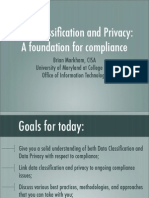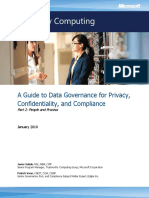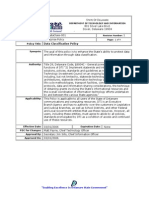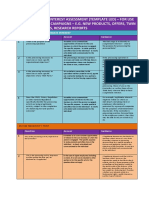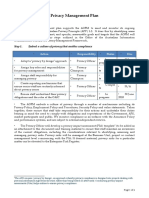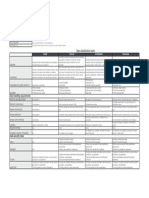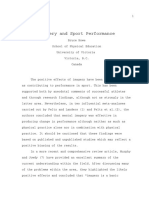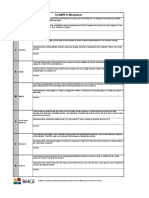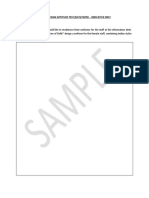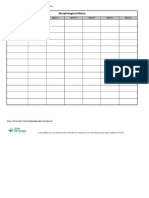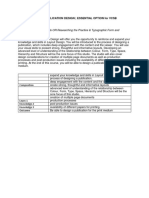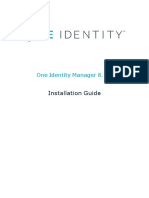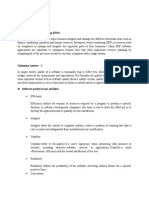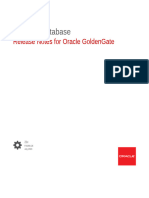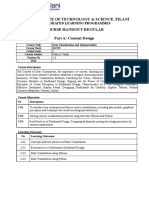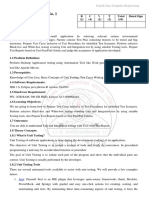Data Classification Template
blank
blank
blank
1. General Information
blank
blank
blank
blank
ORGANIZATION
[Insert name of organization here]
DATE ADOPTED
[Insert date adopted here]
2. Data Classification Levels
Public
Sensitive
Confidential
Regulated
Definition
Information that is freely and without reservation made available
to the public.
Information that could be subject to release under an open records Information that typically is excepted from the Public Information
requests, but should be controled to protect third parties
Act
Information that is controlled by a state or federal regulation or
other 3rd party agreement
Justification
Access to some information, such as published reports, agency
news, and other public related materials, does not need to be
tracked or monitored. In such circumstances, it is most efficient to
keep the information available for citizen access without requiring
the intervention of state employees.
Some information, even though it is available to the public, may
contain sensitive information. Such data should be vetted/verified
before it is released. By protecting access to the data and requiring
an open records request, the organization ensures that the most
accurate and relevant data is provided to the requestor without
accidentally disclosing confidential data.
State agencies and institutes of higher education collect and
maintain some information that is protected from disclosure either
through a codified exception to the Public Information Act or
through opinions or decisions of the Attorney Generals Public
Information office. Such information may also be subject to breach
notification requirements under Texas law.
Many agencies and institutes of higher education interact with the
federal government or perform services that are regulated by
federal rules and laws. In such instances, the information
maintained by those agencies must comply with federal controls.
Examples
Information that is published to the public website and requires no Data that meets the definition of PII under the Texas Business and
authentication
Commerce Code 521.002(a)(1) and 521.002(a)(2)
Agency publications
Employee Records
Press releases
Gross Salary Information
Public web postings
Data that has been excepted from public release under the Texas
Government Code Ch. 552 or data, whose pubic release, may
result in adverse consequences to the organization
Attorney-Client communications
Computer Vulnerability Reports
Protected draft communications
Net salary information
Data that meets the definition of SPI under the Texas Business and
Commerce Code 521.002(a)(1) and 521.002(a)(2): HIPAA Security
(45 CFR Parts 164), PCI DSS v2.0, FTI, FICA, tax information
Consequence of Public Disclosure
No adverse consequences
Loss of reputation
Loss of trust
Potential criminal or civil penalties
Federal investigation or loss of right to collect revenue
Sample Security Controls
blank
blank
blank
blank
3. Roles and Responsibilities
Public
Sensitive
Confidential
Regulated
Data Custodian
Ensure systems support access controls which enforce data
classification
Ensure systems support access controls which enforce data
classification
Ensure systems support access controls which enforce data
classification
Ensure systems support access controls which enforce data
classification
Data Owner
Identify the classification level of data
Review audit logs
Identify the classification level of data
Review audit logs
Identify the classification level of data
Review audit logs
Identify the classification level of data
Review audit logs
Information Security Officer
Develop and maintain information security policies,
procedures, and guidelines
Provide guidance on data classifications
Develop and maintain information security policies,
procedures, and guidelines
Provide guidance on data classifications
Develop and maintain information security policies,
procedures, and guidelines
Provide guidance on data classifications
Develop and maintain information security policies,
procedures, and guidelines
Provide guidance on data classifications
Legal and/or Privacy Office
(Public Information Officer)
Develop and maintain information security policies,
procedures, and guidelines.
Provide guidance on data classifications
Develop and maintain information security policies,
procedures, and guidelines.
Provide guidance on data classifications
Develop and maintain information security policies,
procedures, and guidelines.
Provide guidance on data classifications
Develop and maintain information security policies,
procedures, and guidelines.
Provide guidance on data classifications
Managers
n/a
Ensure users are aware of data classification requirements
Monitor user activities to ensure compliance
Ensure users are aware of data classification requirements
Monitor user activities to ensure compliance
Ensure users are aware of data classification requirements
Monitor user activities to ensure compliance
Users
n/a
Identify, and Label where appropriate, Data
Properly Dispose of Data
Identify, and Label where appropriate, Data
Properly Dispose of Data
Identify, and Label where appropriate, Data
Properly Dispose of Data
DATA CLASSIFICATION TEMPLATE
PAGE 1 OF 5
�4. Data Controls
Public
Sensitive
Confidential
Regulated
Marking
n/a
All sensitive data shall be marked as such
Special handling instructions must be provided
Handling
n/a
n/a
Confidential data shall only be given to those persons with
authorization and a need to know
Confidential data shall only be given to those persons with
authorization and a need to know
Duplication
n/a
Mailing
n/a
Information to be duplicated for business purposes or in
response to an "Open Records" request only
n/a
Employees can duplicate confidential documents with data
owners authorization
n/a
Employees can duplicate confidential documents with data
owners authorization
Confirmation of receipt required
May require double-packaged delivery. Outside of the
package is not marked. Inside paperwork is appropriately
marked.
Disposition
Disposition based on requirements of the records retention Disposition based on requirements of the records retention Disposition based on requirements of the records retention
schedule.
schedule.
schedule.
Physical destruction required (e.g. shredding)
Destruction must be verified by agency personnel
Disposition based on requirements of the records retention
schedule.
Physical destruction required (e.g. shredding)
Destruction must be verified by agency personnel
Storage of hardcopy
Store a "Master copy" in compliance with records retention Store a "Master copy" in compliance with records retention
schedule.
schedule.
Documents should be locked up when not in use (e.g., in
locked desk, cabinet or office)
Store a "Master copy" in compliance with records retention
schedule.
Documents should be locked up when not in use (e.g., in
locked desk, cabinet or office)
Store a "Master copy" in compliance with records retention
schedule.
Documents should be locked up when not in use (e.g., in
locked desk, cabinet or office)
Storage on fixed media
n/a
Access is password controlled
Access is password controlled
Encryption required
Access is password controlled
Encryption required
Storage on removable media
n/a
Encryption recommended
Encryption required.
Encryption required.
5. Access Controls
Public
Sensitive
Confidential
Regulated
Granting Access Rights
No Restrictions
Data owner only
Data owner only
Data owner only
Read Access
Information owner defines permissions by user/role
Information owner defines permissions by user/role
Update Access
Information owner defines permissions by user/role
Information owner defines permissions by user/role
Controls (e.g., separation of duties) needed for processes
and transactions that are susceptible to fraudulent or other
unauthorized activities
Information owner defines permissions by user/role
Access highly restricted or controlled
Information owner defines permissions by user/role
Controls (e.g., separation of duties) needed for processes
and transactions that are susceptible to fraudulent or other
unauthorized activities
Information owner defines permissions by user/role
Access highly restricted or controlled
Information owner defines permissions by user/role
Controls (e.g., separation of duties) needed for processes
and transactions that are susceptible to fraudulent or other
unauthorized activities
Delete Access
Information owner defines permissions by user/role
Information owner defines permissions by user/role
Information owner defines permissions by user/role
Controls (e.g., separation of duties) needed for processes
and transactions that are susceptible to fraudulent or other
unauthorized activities
Information owner defines permissions by user/role
Controls (e.g., separation of duties) needed for processes
and transactions that are susceptible to fraudulent or other
unauthorized activities
6. Transimssion Controls
Public
Sensitive
Confidential
Regulated
Print Controls
No restrictions
Information owner define permissions
Output routed to pre-defined printer and monitored or secure Output routed to pre-defined printer and monitored or secure
printing enabled
printing enabled
Transmission by public network
No restrictions
Encryption Recommended
Encryption Required
Encryption Required
Release to Third Paries
No restrictions
No restrictions
Owner Approval and Non-Disclosure Agreement
Owner Approval and Non-Disclosure Agreement
DATA CLASSIFICATION TEMPLATE
All sensitive data shall be marked as such
Special handling instructions must be provided
Each page if loose sheets
Front and back covers, and title page if bound
All sensitive data shall be marked as such
Special handling instructions must be provided
Each page if loose sheets
Front and back covers, and title page if bound
PAGE 2 OF 5
�7. Audit Controls
Public
Sensitive
Confidential
Regulated
Tracking Process by Log
n/a
n/a
Recipients, Copies Made, Locations, Addresses, Those Who
Viewed, and Destruction
Recipients, Copies Made, Locations, Addresses, Those Who
Viewed, and Destruction
Auditing acess activity
n/a
IT system should be configured to log all violation attempts.
Audit trails should be maintained to provide for accountability
of modifications to information resources and for all changes
to automated security/access rules
IT system should be configured to log all violation attempts.
Audit trails should be maintained to provide for accountability
of modifications to information resources and for all changes
to automated security/access rules
IT system should be configured to log all violation attempts.
Audit trails should be maintained to provide for accountability
of modifications to information resources and for all changes
to automated security/access rules
Retention criteria for Access
Reports
Logs must be retained in accordance with records retention
guidelines
Logs must be retained in accordance with records retention
guidelines
Logs must be retained in accordance with records retention
guidelines
Logs must be retained in accordance with records retention
guidelines
Retention criteria for Access
Reports
Classification review cycle
timeframe
n/a
The owner determines retention of violation logs
The owner determines retention of violation logs
The owner determines retention of violation logs
Review & affirm date must be set but flexible, i.e., 1-2 years
Review & affirm date must be set but flexible, i.e., 1-2 years
Info Owner must review & affirm all info classification and
user rights, not to exceed 1 year
Info Owner must review & affirm all info classification and
user rights, not to exceed 1 year
8. Notification Requirements
Public
Sensitive
Confidential
Regulated
Required Disclosure to Data Subject No disclosure of public information
No disclosure of public information
No disclosure of public information
No disclosure of public information
Required Disclosure to Public
No disclosure of public information
No disclosure of public information
No disclosure of public information
No disclosure of public information
Required Disclosure to Federal
Partners
No disclosure of public information
No disclosure of public information
No disclosure of public information
No disclosure of public information
Required Disclosure to State
Partners
No disclosure of public information
No disclosure of public information
No disclosure of public information
No disclosure of public information
Required Disclosure to Third Parties No disclosure of public information
No disclosure of public information
No disclosure of public information
No disclosure of public information
DATA CLASSIFICATION TEMPLATE
PAGE 3 OF 5
�Term
Definition
�Reference

